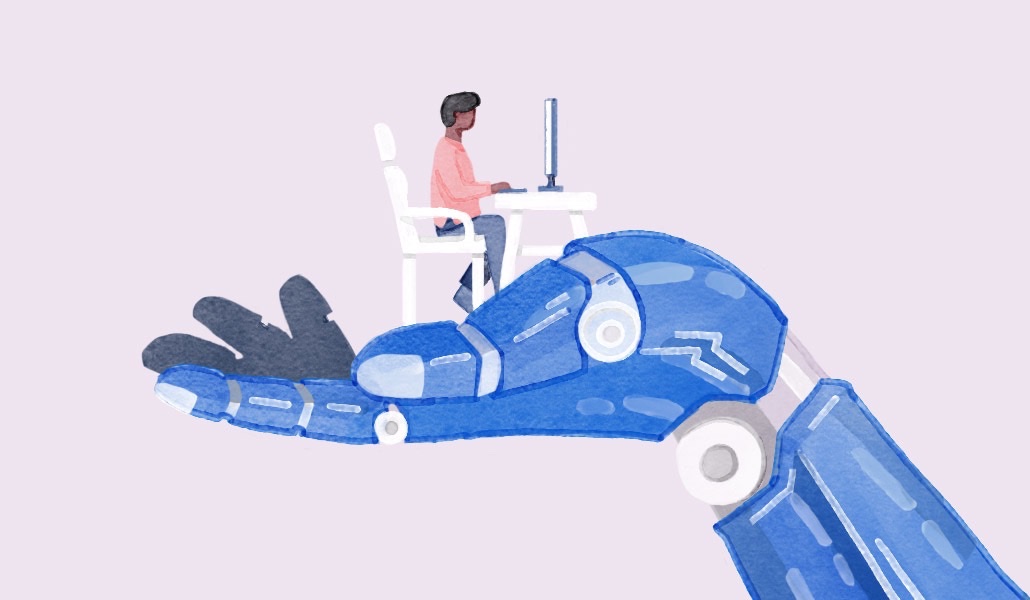How AI tools are improving engagement in ‘on-screen office’ era

Both hybrid working and the evolution of artificial intelligence tools have upped the ante for the workplace visual economy.
Opening a presentation deck that’s densely packed with text and few visuals is enough to kill the spirits of the most die-hard audience. Naturally, that’s a rare sight today. But the rise of hybrid working has meant that everyone now needs to improve their visual communication methods, not just those adept at creating pitch decks for clients. And the proliferation of AI tools flooding the market, that can help cut the time spent making presentations look good, will make visual storytelling more of a must-have skill across all desk-based workers.
It’s all a part of today’s visual, screen-sharing economy. Prolific social media use has been linked to shrinking attention spans – people are more engaged, and influenced, by visual (rather than text) communication methods.
A well-designed presentation can be the difference between winning a client, landing a job, communicating a strategy, or sharing business results that land. It can be your assistive ‘silent’ partner in building your presenting and public speaking confidence.
Most (90%) of business leaders say that visual communication tools, like presentations and decks, increase efficiency, 89% say it enhances collaboration, 85% say they carry more authority and 89% say they have a positive return on investment, per a report from visual communication platform Canva.
And now more tools are becoming available, that make it possible for anyone to put together slick decks, without needing a background in graphic design.
Workers that use such tools, say it’s helped boost their confidence.
“We have data analytics for our clients and it’s about communicating that in a visually appealing way,” said Ari McDaniel, head of community relations for the Black Tech PR Society. “We can’t just throw numbers and words on a deck. It has to be visually satisfying.”
McDaniel uses Canva for the majority of her decks, taking advantage of its new AI tools like ‘magic write’ that kicks off the first draft of copy. Using tools like these have made McDaniel’s job easier, especially when working on tight deadlines or with small budgets, she said. And she is also much more confident presenting than she was previously.
“I just presented my Canva deck to an executive at Pepsi, and I had confidence knowing that the information that I was presenting to them looked good and professional,” said McDaniel. “And the fact you put it together yourself is nice too. The fact you didn’t have to outsource it to the design team.”
Antonio Naglieri, cofounder of business transformation company JukeStrat has been using Canva’s AI image generator. He recently had a presentation that needed to include headshots, but when one person didn’t have one, he was able to edit a casual image using the tool to make it look professional and match the other headshots.
Jen Thompson, product marketing group lead at Canva, says that by prioritizing visuals, people can understand what you are trying to say much more clearly, which is especially beneficial in a hybrid setting where people are trying to keep meeting times to a minimum. It also cuts down on the amount of prep time someone needs to create the presentation.
“I can pull together a presentation in like 20 minutes these days, just because I don’t have to reinvent the wheel every time,” said Thompson. “This information exists out in the ether and we’re just pulling it together in one place so people can make it their own.”
It also helps the 65% of the population that are visual learners.
“Giving people both visual cues as well as written cues means that you have a much higher likelihood of them understanding the message you are trying to portray,” said Thompson. “You can have a meaningful back and forth because they’ve quickly picked up what you’re trying to get to.”
McDaniel doesn’t just use Canva. She’s still a Photoshop and InDesign user too, which she leans on for larger projects or building out templates. She’s only just started playing around with Photoshop/s Firefly Generative AI tool that was released at the end of May. The generative fill tool allows users to add content, remove or replace parts of an image or extend the edges of an image. While not necessarily for making presentations and decks better, it is a part of the larger conversation around the visual economy.
Visual communications firm Prezi claims 200,000 organizations use its video presentation tool for online meetings. Its tools are designed to create an “onscreen office” by layering content on your Zoom call, allowing people to add name and title inside their box, add branded backgrounds, bring in data and charts, or even full presentations in a way that doesn’t block your face.
“Video screen usage is continuing to be a very consistent place where people are getting work done,” said Jim Szafranski, CEO of Prezi. “We call that the on-screen office. Having really good content on screen during meetings is key to productivity and having your audience invested in whatever the meeting is.”
Aside from the meeting host, it’s a beneficial feature for participants who can send notes onto their screen without interrupting the meeting or send emojis in response to what is being shared.
“Diving in and doing a full pitch for 30 minutes in front of your boss, your boss’s boss, that’s stressful,” said Szafranski. “But it’s the idea of engaging the audience and having them be excited about the meeting.”
Curtis Morley, an entrepreneur coach, said he’s been using Prezi to enhance his messages and presentations. He uses it to create engagement with his clients, and states that ultimately it helps build trust and foster engagement and allows his messaging to come across even stronger than if he didn’t use it.
“Prezi allows my audience to visually travel a three-dimensional landscape with me,” said Morley. “I frequently get asked which professional design agency I hired to create my presentations that only took me minutes to build myself.”

